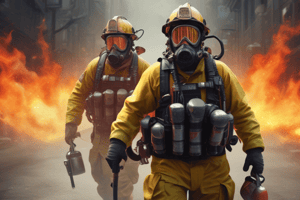Podcast
Questions and Answers
What is the primary rationale behind the establishment of the 150-foot rule in firefighting operations?
What is the primary rationale behind the establishment of the 150-foot rule in firefighting operations?
- To allow firefighters sufficient time to establish a connection to the water supply.
- To ensure retreat is possible before the low air alarm sounds. (correct)
- To maximize the distance from smoke and heat sources.
- To ensure fire companies can operate without a hose line.
Which of the following factors can limit the maximum distance fire companies should operate inside a structure?
Which of the following factors can limit the maximum distance fire companies should operate inside a structure?
- Building aesthetics
- Firefighter experience level
- Interior obstacles (correct)
- Weather conditions outside the structure
In what context is the 150-foot rule specifically applied within mid-rise and high-rise buildings?
In what context is the 150-foot rule specifically applied within mid-rise and high-rise buildings?
- From the base of the building to the first floor.
- From the top floor to the ground level.
- From the exterior of the building to the nearest fire hydrant.
- From an area of safe refuge to the end of the hoseline length. (correct)
What type of areas are classified as areas of safe refuge during firefighting operations?
What type of areas are classified as areas of safe refuge during firefighting operations?
How is the 150-foot measurement adjusted when fire crews enter a structure without protected areas of refuge?
How is the 150-foot measurement adjusted when fire crews enter a structure without protected areas of refuge?
Flashcards are hidden until you start studying
Study Notes
150 Foot Rule
- Firefighters should not operate over 150 feet into a structure during firefighting operations to ensure safe retreat before low air alarms activate.
- This guideline was established following the Line of Duty Death (LODD) of Firefighter Brett Tarver by the Phoenix Fire Department.
- The 150-foot limit is based on standard attack line lengths and SCBA (Self-Contained Breathing Apparatus) air capacity, allowing time for ingress, work, and egress.
- Several factors can affect the maximum safe operating distance inside a structure:
- Smoke and fire conditions
- Building construction and layout
- Type of occupancy
- Interior obstacles
- Physical effort required to advance, which can increase air consumption rate.
- For mid-rise and high-rise buildings, the 150-foot rule applies from the exterior entrance or other protected interior access points to the end of the hoseline.
- The distance is measured from any area of safe refuge, including stairwells and landings, which can be secured to minimize smoke and fire intrusion.
- Areas of safe refuge can include:
- Stairwells that can be protected with doors
- Spaces with standpipes for fire hose connections that can be pressurized to keep smoke and fire out.
Studying That Suits You
Use AI to generate personalized quizzes and flashcards to suit your learning preferences.




